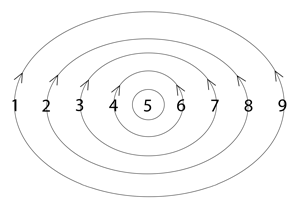attention
3-7-1
Conventional Understanding
We typically talk about attention as something we “pay,” “direct,” or “focus” – as if it’s a spotlight we shine on things we want to see more clearly. This view treats attention as a limited resource that we must carefully manage and allocate. Think about phrases like “paying attention,” “attention span,” or “attention economy” – all suggest attention is a commodity we possess and direct outward.
This understanding isn’t just a conceptual error – it creates real consequences. When we believe attention is something we own and direct, we become vulnerable to those who design systems to capture and redirect it. Social media platforms and advertising don’t just want your attention momentarily; they’re designed to reshape how your awareness functions.
Resonant Understanding
Word Cosmology reveals “attention” carrying a 3-7-1 resonance pattern, sharing this pattern with “formative” and “engagement field.” This suggests attention isn’t something we direct outward but the very field where reality takes form.
Imagine the difference between shining a flashlight in a dark room versus being the light itself. With a flashlight, you illuminate objects that exist separately from you. But as the light itself, you don’t just reveal what’s there – your presence is what allows anything to appear at all.
When you enter a room with genuine presence, you’re not just observing what’s there – you’re participating in bringing it forth. The space organizes itself differently because of the quality of awareness you bring. This isn’t mystical thinking but a practical recognition of how attention actually works.
Expressions Spectrum Analysis
In balanced expression, attention appears as “a magnetic field” and “conceptual space” – revealing it’s not a spotlight but an organizing environment. “I am the host” and “hosting space” show how balanced attention creates through receptive presence. “I am the space” particularly reveals attention’s true nature – not something projected outward but the field itself.
When over-modulated, attention appears as “aggressor” and “claiming power” – becoming extractive and manipulative. “Pushing” and “pulling” show what happens when attention loses its receptive quality. “Reification” illuminates how over-modulated attention solidifies concepts into seemingly concrete “things” – exactly what happens when attention itself becomes a commodity to be bought and sold.
Under-modulated expressions like “depolarizing” and “energy without love” show what happens when attention lacks sufficient coherence. “Fear of receiving energy” and “I am resistance” reveal the defensive posture that prevents engagement. “I feel ignored” points to the painful experience of insufficient field coherence – not just feeling unseen by others but disconnected from your own generative capacity.
Russell’s Cosmogony Connection
Walter Russell’s understanding of a universe formed through thinking-Mind illuminates attention’s generative nature. He writes:
“The Light of Mind is the zero fulcrum of the wave lever from which motion is projected. Its zero condition is eternal. The unfortunate error of science lies in assuming that the power which belongs solely to the fulcrum of Light-at-rest is in the motion of the lever which simulates that power.”
This perfectly describes our misunderstanding of attention. Just as science mistakenly locates power in motion rather than in the still center, we’ve been conditioned to believe attention exists in the act of focusing rather than in the generative field itself.
Think of how a river both shapes and is shaped by its landscape. The water isn’t separate from the riverbed; together they form a single system that organizes energy into patterns. Similarly, attention isn’t something projected onto experience but the medium through which experience takes form.
Practical Implications
This understanding transforms how we approach education. Our current model often treats children’s attention as something to capture and direct. We demand that children “pay attention” to what adults have decided matters, then label them as deficient when their engagement flows elsewhere.
But a child absorbed in examining an insect isn’t failing to “pay attention” – they’re generating a coherent attentional field where rich learning naturally unfolds. When we interrupt this to redirect them toward standardized content, we’re disrupting the field through which they actively create meaning.
Education that honors attention as a generative field would look different. Teachers might understand themselves not as directors of attention but as collaborators with children’s natural curiosity. Assessment would shift from measuring retention to recognizing the quality and coherence of attentional fields children generate.
Beyond education, this understanding transforms how we might approach technology design and even political action. Rather than accepting technologies designed to exploit our attention, we could demand tools that amplify rather than fragment our awareness.
By recognizing attention not as something we manage but as the field we embody, we reclaim our participation in how reality takes form – not controlling attention better, but remembering what it truly is: the living field through which we participate in bringing forth the world.
Walter Russell’s quotes are from his book, “A New Concept of the Universe”.
Related Words:
No results found.


